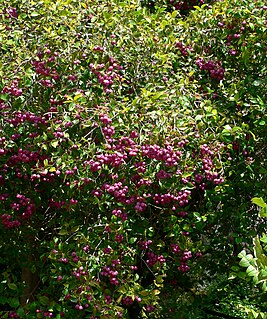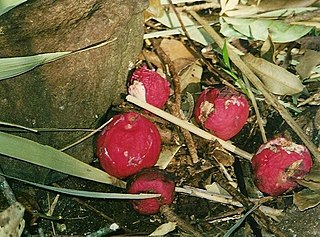
Syzygium smithii is a summer-flowering, winter-fruiting evergreen tree, belonging to the myrtle family Myrtaceae. It shares the common name "lilly pilly" with several other plants. In New Zealand, it is commonly known as 'monkey apple'. It is planted as shrubs or hedgerows, and features: rough, woody bark; cream and green smooth, waxy leaves; flushes of pink new growth; and white to maroon edible berries. Unpruned, it will grow about 3–5 m (9.8–16.4 ft) tall in the garden.

Syzygium luehmannii is a medium-sized coastal rainforest tree native to Australia. Common names include riberry, small leaved lilly pilly, cherry satinash, cherry alder, or clove lilli pilli.

Syzygium australe, with many common names that include brush cherry, scrub cherry, creek lilly-pilly, creek satinash, and watergum, is a rainforest tree native to eastern Australia. It can attain a height of up to 35 m with a trunk diameter of 60 cm. In cultivation, this species is usually a small to medium-sized tree with a maximum height of only 18m.

Syzygium moorei is a rare sub tropical rainforest tree, growing on volcanic soils in the Mount Warning area of north east New South Wales and south east Queensland, Australia. Common names include coolamon, watermelon tree, durobby and robby; it is also called "rose apple" but this can refer to many species of Syzygium.

Syzygium crebrinerve is a fairly common Australian tree, growing from near Taree, New South Wales to Calliope in Queensland. Common names include purple cherry, rose satinash, and black water gum. The habitat of Syzygium crebrinerve is sub tropical rainforest on basaltic or fertile alluvial soils.

Syzygium corynanthum, commonly known as sour cherry and Killarney satinash, is a common Australian tree which grows in surrounding areas from Taree, New South Wales to tropical Queensland.The habitat of Syzygium corynanthum is rainforest on basaltic or fertile alluvial soils.

Syzygium francisii is a native Australian tree, common on the eastern sea board, between Morisset, New South Wales and Gladstone, Queensland. Common names include giant water gum, rose satinash, and Francis water gum. The habitat of Syzygium francisii is rainforest on basaltic or fertile alluvial soils.

Cryptocarya obovata is a large laurel growing on basaltic and fertile alluvial soils in eastern Australian rainforests. It is found from Wyong in New South Wales to Gympie in the state of Queensland. Extinct in the Illawarra region, allegedly seen in the Illawarra in 1818 by Allan Cunningham. The species was included in the Prodromus Florae Novae Hollandiae et Insulae Van Diemen, 402 (1810)

Syzygium ingens, commonly known as red apple, is a species of flowering plant that is endemic to eastern Australia. It is a medium-sized to tall rainforest tree with narrow elliptic to oblong leaves and panicles of white flowers on the ends of branchlets, followed by spherical red berries.

Auranticarpa rhombifolia is a rainforest tree of eastern Australia. Known as the diamond leaf pittosporum, this tree is planted in many parts of Australia as an ornamental. The white flowers and orange fruit make it a most appealing street or garden tree. Other common names include hollywood, diamond leaf laurel, white myrtle and white holly.

Syzygium hemilamprum, commonly known as the broad-leaved lilly pilly, blush satinash, cassowary gum, Eungella gum, and treated as Acmena hemilampra in New South Wales and Queensland, is a species of flowering plant in the family Myrtaceae and is native to New South Wales, Queensland and the Northern Territory. It is a rainforest tree with broadly lance-shaped to elliptic leaves, panicles of white flowers and more or less spherical white fruit.

Macaranga tanarius is a plant found in South East Asia, Thailand, Papua New Guinea, Taiwan, and eastern Australia. It is commonly seen as a pioneer species in disturbed rainforest areas. Easily recognised for the round veiny leaves. In Australia it naturally occurs from the Richmond River, New South Wales to Cooktown in tropical Queensland.

Endiandra pubens is a rainforest tree growing in eastern Australia. The habitat is subtropical rainforest growing near streams in valleys. The range of natural distribution is from the Bellinger River, New South Wales to Bulburin National Park, south west of Gladstone, Queensland.

Backhousia subargentea is a rare Australian rainforest tree, growing near Mullumbimby in north eastern New South Wales and from Boonah to Imbil in south eastern Queensland.

Claoxylon australe, known as brittlewood is a common rainforest shrub or understorey tree. The habitat is all types of eastern Australian rainforests. The natural range of distribution is from Eden in south eastern New South Wales to Bowen in tropical Queensland.

Croton verreauxii known as the green native cascarilla is a small tree or shrub growing in dry rainforest and rainforest margins in eastern Australia.

Endiandra discolor is an Australian tree, growing from near Gosford, New South Wales to Tully, Queensland in the tropics. Common names include rose walnut and domatia tree.

Endiandra virens is an Australian tree in the laurel family. Growing from Boorganna Nature Reserve north west of Taree, New South Wales to Kin Kin in Southern Queensland. Common names include White Apple, Plumwood, and New South Wales Walnut.

Gossia acmenoides, known as the scrub ironwood, is a rainforest tree of the family Myrtaceae, native to eastern Australia. The usual habitat of this small tree is drier rainforest areas. The range of natural distribution is from Jamberoo in New South Wales to Eungella National Park in northern Queensland.

Decaspermum humile, commonly known as the silky myrtle, is a tree from Australia and Asia. It can be used as bush food, as indicated by the alternate common name of currant myrtle. The tree features an attractive dark glossy crown. The new pink leaves with silvery hairs are particularly appealing.




















